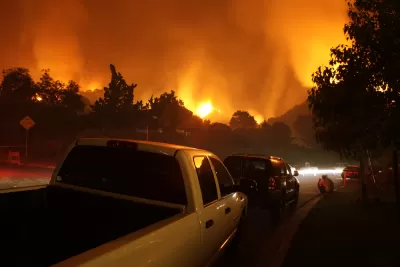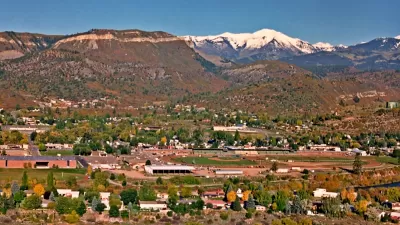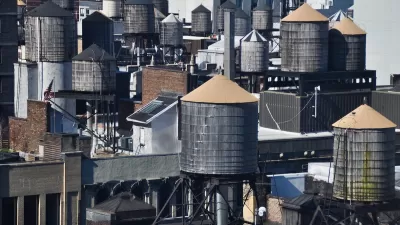Wildfire planning often focuses on individual buildings, but little guidance exists for effective citywide evacuation planning.

Increasingly powerful fires are devastating communities around the world, with tens of thousands of people already affected this year. “And yet, when it comes to things like planning evacuations, best practices don’t really exist—there’s no book to consult, no checklist to follow,” writes Caroline Mimbs Nyce in The Atlantic.
“The reason for this is that wildfire-evacuation research is still in its infancy,” Mimbs Nice explains. Although robust fire codes for buildings do exist, the same can’t be said for whole communities. Meanwhile, the unpredictable nature of fire makes it difficult to model predicted outcomes and establish protocols.
Mimbs Nyce outlines the challenges faced by authorities and residents during a fire: notification, time to meet with loved ones and get essentials, and transit time out of an affected area, which can be affected by road design, exit routes, and traffic. In addition to evacuation preparations, a town can also designate a highly protected gathering place as a refuge for people unable to flee.
Ali Mosleh, director of the B. John Garrick Institute for the Risk Sciences at UCLA, emphasizes the importance of developing standards catered to the needs of different types of communities. “They might need different numbers of evacuation routes, and different sorts of community-warning systems. Existing tools and simulations, like the one run on Camp Fire data, can help guide policy makers.”
FULL STORY: The World Needs to Start Planning for the Fire Age

Study: Maui’s Plan to Convert Vacation Rentals to Long-Term Housing Could Cause Nearly $1 Billion Economic Loss
The plan would reduce visitor accommodation by 25,% resulting in 1,900 jobs lost.

North Texas Transit Leaders Tout Benefits of TOD for Growing Region
At a summit focused on transit-oriented development, policymakers discussed how North Texas’ expanded light rail system can serve as a tool for economic growth.

Using Old Oil and Gas Wells for Green Energy Storage
Penn State researchers have found that repurposing abandoned oil and gas wells for geothermal-assisted compressed-air energy storage can boost efficiency, reduce environmental risks, and support clean energy and job transitions.

Private Donations Propel Early Restoration of Palisades Playground
Los Angeles has secured over $1.3 million in private funding to restore the Pacific Palisades playground months ahead of schedule, creating a modern, accessible space that supports community healing after recent wildfires.

From Blight to Benefit: Early Results From California’s Equitable Cleanup Program
The Equitable Community Revitalization Grant (ECRG) program is reshaping brownfield redevelopment by prioritizing projects in low-income and environmental justice communities, emphasizing equity, transparency, and community benefits.

Planting Relief: Tackling Las Vegas Heat One Tree at a Time
Nevada Plants, a Las Vegas-based nonprofit, is combating the city’s extreme urban heat by giving away trees to residents in underserved neighborhoods, promoting shade, sustainability, and community health.
Urban Design for Planners 1: Software Tools
This six-course series explores essential urban design concepts using open source software and equips planners with the tools they need to participate fully in the urban design process.
Planning for Universal Design
Learn the tools for implementing Universal Design in planning regulations.
Ascent Environmental
Borough of Carlisle
Institute for Housing and Urban Development Studies (IHS)
City of Grandview
Harvard GSD Executive Education
Toledo-Lucas County Plan Commissions
Salt Lake City
NYU Wagner Graduate School of Public Service





























